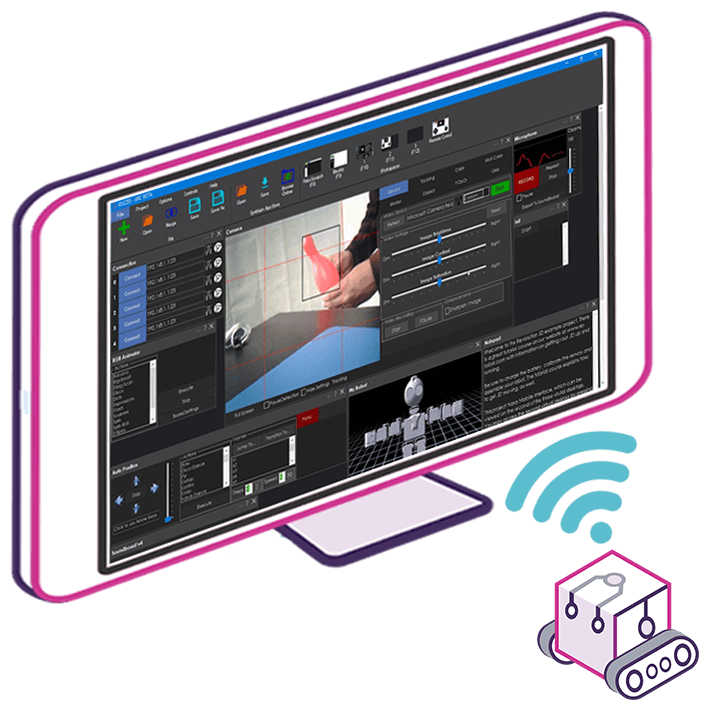Example: Camera Custom Tracking Type
As you've seen in the previous tutorial step about detecting and attaching to the camera, there are a bunch of events that you can use. One of the events allows you to create a custom tracking type as a plugin, which is real cool!
Uses for creating a custom tracking type is if you want to experiment with OpenCV or any other vision libraries. Because ARC leverages .Net, we recommend the x86 nuget install of EMGUCV (https://github.com/emgucv/emgucv). Installing from NUGET is the easiest and most convenient.
The camera events that we'll use for creating a custom tracking type are...
// assign an event that raises when the camera wants to initialize tracking types
_camera.Camera.OnInitCustomTracking += Camera_OnInitCustomTracking;
// assign an event that raises with a new frame that you can use for tracking
_camera.OnCustomDetection += Camera_OnCustomDetection;
Once inside the OnCustomDetection() event, you have access to a bunch of different bitmaps throughout the flow of the detection process. They are...
// **********************
// From the EZ_B.Camera class
// **********************
///
/// This is a temporary bitmap that we can use to draw on but is lost per tracking type
///
public volatile Bitmap _WorkerBitmap;
///
/// This is the resized original bitmap that is never drawn on. Each tracking type uses this as the main source image for tracking, and then draws on the _OutputBitmap for tracking details
///
public volatile AForge.Imaging.UnmanagedImage _OriginalBitmap; // resized image that we process
///
/// Image that is outputted to the display. We draw on this bitmap with the tracking details
///
public volatile AForge.Imaging.UnmanagedImage _OutputBitmap;
///
/// Raw image unsized directly from the input device
///
public volatile AForge.Imaging.UnmanagedImage _RawUnsizedBitmap;
///
/// Last image for the GetCurrentImage
///
public volatile AForge.Imaging.UnmanagedImage _RawUnsizedLastBitmap;
Understanding the images available, the ones we care about for creating a tracking type of our own are...
///
/// This is the resized original bitmap that is never drawn on. Each tracking type uses this as the main source image for tracking, and then draws on the _OutputBitmap for tracking details
///
public volatile AForge.Imaging.UnmanagedImage _OriginalBitmap; // resized image that we process
///
/// Image that is outputted to the display. We draw on this bitmap with the tracking details
///
public volatile AForge.Imaging.UnmanagedImage _OutputBitmap;
This is because we can use the _OriginalBitmap for our detection, and then draw on the _OutputBitmap where our detection was.
Example This is an example that fakes detection by drawing a rectangle on the _OutputBitmap that bounces around the screen. It moves with every frame in the CustomDetection event.
// faking an object being tracked
int _xPos = 0;
int _yPos = 0;
bool _xDir = true;
bool _yDir = true;
private EZ_B.ObjectLocation[] Camera_OnCustomDetection(EZ_Builder.UCForms.FormCameraDevice sender) {
if (_isClosing)
return new ObjectLocation[] { };
if (!_camera.Camera.IsActive)
return new ObjectLocation[] { };
List objectLocations = new List();
try {
// This is demonstrating how you can return if an object has been detected and draw where it is
// The camera control will start tracking when more than one ObjectLocation is returned
// We're just putting fake bouncing rectable of a detected rect which will be displayed as a tracked object on the screen in the camera device
if (_xDir)
_xPos += 10;
else
_xPos -= 10;
if (_yDir)
_yPos += 10;
else
_yPos -= 10;
var r = new Rectangle(_xPos, _yPos, 50, 50);
if (r.Right > _camera.Camera._OutputBitmap.Width)
_xDir = false;
else if (r.Left _camera.Camera._OutputBitmap.Height)
_yDir = false;
else if (r.Top <= 0)
_yDir = true;
var objectLocation = new ObjectLocation(ObjectLocation.TrackingTypeEnum.Custom);
objectLocation.Rect = r;
objectLocation.HorizontalLocation = _camera.Camera.GetHorizontalLocation(objectLocation.CenterX);
objectLocation.VerticalLocation = _camera.Camera.GetVerticalLocation(objectLocation.CenterY);
objectLocations.Add(objectLocation);
AForge.Imaging.Drawing.Rectangle(_camera.Camera._OutputBitmap, r, Color.MediumSeaGreen);
} catch (Exception ex) {
EZ_Builder.EZBManager.Log(ex);
}
return objectLocations.ToArray();
}

Is this out of date? There doesn't seem to be a GetConfiguration function within EZ_Builder.Config.Sub.PluginV1
Look at the tutorial step titled "Code: Saving/Loading Configuration"
The get and set configuration methods are overrides of the form. There’s a great video on the first step of this tutorial that demonstrates the step by step of building a plugin. I recommend watching that because it helps fill in any steps that were missed.
When you’ve done it once, it makes sense and voila, you can rinse and repeat
Excellent, thanks - I will do. I really must learn not to just jump ahead in the process
Hey no problem - I do it all the time, and end up frustrated because I dont know what it was that I missed. Excitement gets the best of me
Trying to follow the tutorials but can't find where the plugin page has gone. How do I add a new plugin to the ez-robot / Synthiam site to get the XML?
Never mind. Just found the "Create skill control" link
I am trying to follow the instructions for adding my own plugin but I cannot seem to find the place to register the plugin based on the instructions.
Any help is appreciated.
Thanks
The new button to create a plugin skill control is less than an inch below the button you pressed to create this question.